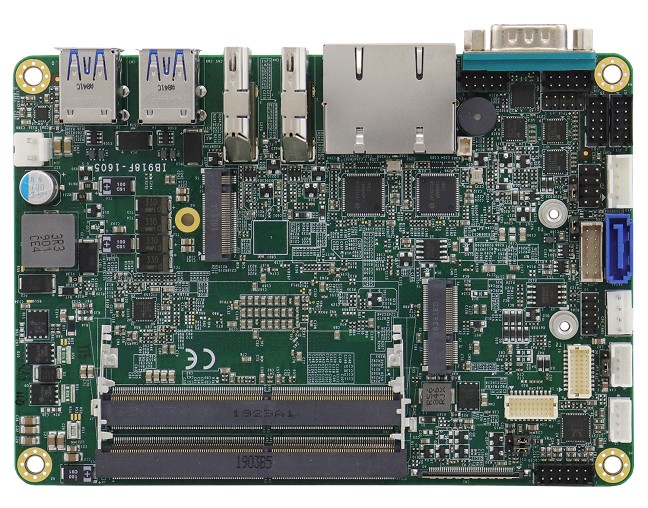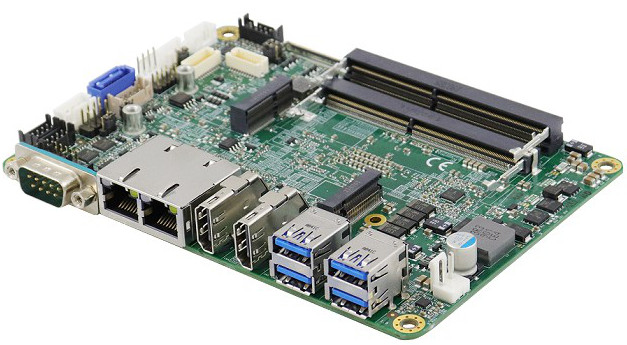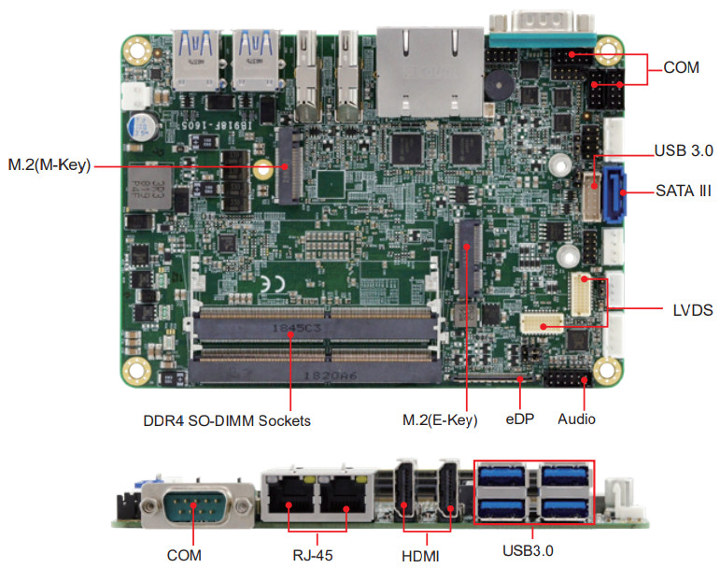The Release of the IB918 SBC
The IBASE Technology Inc has released its IB918 3.5″ disk sized SBC, based on the AMD Ryzen V1000 or R1000 SoC with several different options for the base chip system. The new computers can support Windows or Ubuntu and offer several different core options.


The Basics
The board supports 4 simultaneous 4K displays through 2 HDMI ports, eDP and LVDS, as well as 2x GbE 2.0 and storage options include a SATA III port, and an M.2 NVMe socket. The supports offer a choice in which SoC can be loaded, either the Ryzen Embedded R1000 SoC or the already marketed and more powerful V1000 which supports both Ubuntu and Windows.
Background and other AMD Ryzen Embedded SBC’s
-
- AMD Ryzen Embedded R1000 Series SoC’s
- UDOO BOLT AMD Ryzen Embedded
- Sapphire FS-FP5R 5×5 Motherboard with the embedded AMD Ryzen R1606G or R1505G processor onboard.
- IBASE MI988 with the AMD Ryzen Embedded V1000 SoC Mini ITX Motherboard
The Release of IB918
Although the IB918 was featured at the beginning of 2019, the release of the SBC coincided with the release of the AMD Ryzen Embedded R1000 SoC. With this announcement, the company revealed that the IB918 SBC could also support the V1000 SoC, with support for both Ubuntu and Windows.
Several SoC Options
There are several options to choose from, including quad-core V1605B, the dual-core V1202B, R1606G, and R1505G. Beside the different maximum frequencies and TDP range, all these options are relatively similar, with Zen CPU and the Vega 3 GPU.

4K Support
There is a support to drive 4 simultaneous displays independently at 4K – 60 on the V1000, and 3 displays on the R1000 at 4K.
IB918 FEATURES:
-
- AMD Ryzen Embedded V1000/R1000 SoC
- 2x DDR4 SO-DIMM, Max. 32GB
- 2x PCI-E Gigabit LAN
- 2x HDMI, 1x eDP, 1x 24-bit LVDS dual-channel
- 1x USB 2.0, 4x USB 3.1, 1x SATA III, 4x COM
- 2x M.2 sockets (M/E key)
Production and Pricing
The pricing and shipping are not presented but the unit price can be quoted immediately. See the announcement and product listing for further information about this Ryzen Embedded SBC.
Some of the information in this article was also found in the LinuxGizmos.com article.

Stephen started writing about technology after publishing sci-fi short stories. His first White-Paper, written in 2008, was well received and inspired him to continue writing about technology. Today he writes in the technology space full time, covering a multitude of topics. During the time he wrote part-time he edited hundreds of titles for large publishers, in science and technology. He lives in Staten Island, with his wife and children.
Support CNX Software! Donate via cryptocurrencies, become a Patron on Patreon, or purchase goods on Amazon or Aliexpress







> supports SATA III via an M.2 socket
There is a separate SATA connector and the M.2 socket seems to be NVMe according to the product page.
If we keep going like this, the term SBC is going to mean uATX form factor and <95w TDP by 2022…
Interesting looking boards mind, I just wish that on these higher end devices we could see more than 1 SATA port
“ATX (Advanced Technology eXtended) is a motherboard and power supply configuration specification developed by Intel in 1995 to improve on previous de facto standards like the AT design.”
Yes one could call them “xpuboards?” (cpu/gpu/npu), but where’s the power connector (and it’s obviously no ATX 2.4 compatible one, if it’s the one left of USB connectors).
That does seem very impressive.
If I’d replace my pc, I’d think about something like this.
Tho my pc has already been replaced by my arm-sbc’s.
I guess this would again consume a lot more than my lovely ARM boards.
Great article, thank you.
Signage, industrial from iBase. Expect pricing around $400+. They also have a mini-itx model from earlier this year with NVMe x2 and a PCIe x16 (x8 signal) plus plenty of NICs, video ports and serial ports. It was closer to $500. The big difference between the V1000 and R1000 CPU series is that the former brings 16 PCIe lanes and the latter only 8. So depending on what is onboard, some features might be cut down with the R1000. The only way to know is to read the datasheet or user manual if downloadable. Like all industrial boards it is not a good deal for individuals who want to buy only one unit because you pay full price. In B2B deals the buyer gets discounts when buying by the dozens or the hundreds. Typical case is a kiosk or signage big service company with deals in multiple cities and needs 500 boards for the next 6 months. That’s why vendors don’t put MSRP prices on their site. Each deal is different and obviously most of the B2B buyers request quotes from multiple vendors and the ping pong game starts until a deal is finally signed. This being said, if you really really want such a board at the unit price, they will sell to you, no problemo. For getting acquainted with the who’s who of the major vendors of signage or industrial boards, cnx-software is now a good place which you can complement with linuxgizmos. The thing is that there is more and more overlap between mainstream boards manufacturers (i.e. ASRock, Gigabytes, Zotac, etc) who make small boards for mini-PCs, industrial board manufacturers and finally SBC manufacturers (x86 or ARM.) to the point that it becomes extremely confusing. IMHO, as an individual buyer you get the best feature set/price ratio with the SBCs, except when the SBC is kind of a split personality like the Bolt at $400+. In comparison, the H2 at a quarter of the price leverages the J4105 better than the mainstream small boards based on the same Gemini Lake.